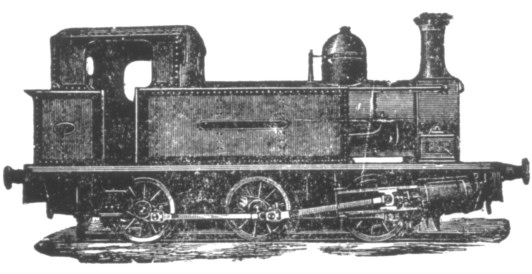
| THE INDUSTRIAL RAILWAY RECORD |
© OCTOBER 1975 |
CORRESPONDENCE
LIGHT RAILWAY AT CEMAES BAY
Is any reader able to throw any light on a narrow gauge line which ran adjacent to a stream (the Afon Wygyr) on the quayside at Cemaes Bay harbour in Anglesey? When I noted the line in July 1955 the rails passed through a bridge under the A5025 road, but south of here had been dismantled. The rails were of very light section and the trackbed well grassed over, but the frame and body of a V‑skip were still present. On returning to the spot (grid reference 372935) a few years later I found that the last tangible traces of the line had been removed.
| COOKHILL, WORCESTERSHIRE |
DAVID R. MORGAN |
AMALGAMATED ROADSTONE
Further to the notes on Penlee Quarries Ltd in RECORD 20 (page 279) and subsequent correspondence, and to the photograph in RECORD 38 (page 106), recent enquiries have revealed further information concerning this locomotive. Page 31 of the January 1910 issue of "The Quarry" contains an advertisement for A. Koppel locomotives which includes the same photograph as in RECORD 38. It is described as a 24in gauge locomotive on trucks in a Cornish Quarry, and accompanied by a testimonial dated 28th August 1906 from the quarry owners which states "In reply to yours of 21st, the narrow gauge locomotive supplied to this Company 4 years ago has given every satisfaction". This would seem to establish that the locomotive was supplied in 1902, probably new. The reason why A. Koppel came to do business with Penlee in 1902 (RECORD 26, page 126) may be quite simply that he advertised in the periodicals applicable to the trade!
| WELLINGBOROUGH |
RUSSELL WEAR |
"A VERY USEFUL FORM OF TANK ENGINE"
The Bagnall locomotive IDDESLEIGH, mentioned on page 30 of RECORD 47, has interested me for some time, as it was illustrated on page 20 of Bagnall's catalogue dated June 1898. I would suggest that it may well have had some connection with Sir Stafford Henry Northcliffe, who was created the first Earl Iddesleigh in 1885, the year IDDESLEIGH was built. He was Member of Parliament for North Devon, where there is a village named Iddesleigh. In 1896 his son was a director of four public companies and it could be that this locomotive was supplied to one of them. Dorman, Brown & Co would appear to be the company of that name which appears in a London directory for 1885 with an office at 2 Talbot Court, Gracechurch Street, London EC. They were described as 'General Merchants', a title which comprised mainly manufacturers' agents and import/export agents. It seems likely, therefore, that IDDESLEIGH was exported.
| WELLINGBOROUGH |
RUSSELL WEAR |
(Frank Jones mentions that he wrote to Lord Iddesleigh some years ago but was informed that there were no family records to throw light on the locomotive IDDESLEIGH. — TJL)

An engraving of Bagnall 614 as featured in early Bagnall catalogues where it was captioned "type lddesleigh". (collection A. C. Baker)
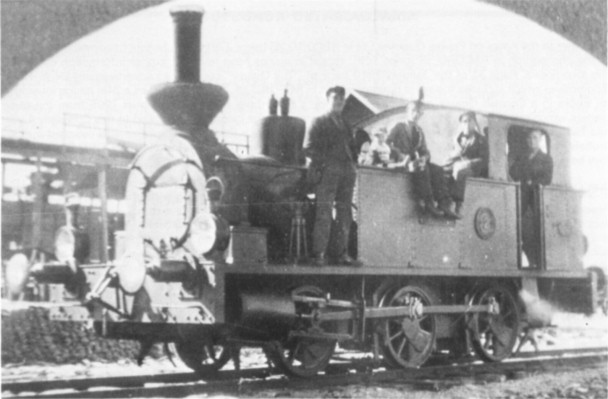
Comparison of this photograph of Laxå-Röfors Railway 2 with the original Bagnall engraving shows a marked similarity between the two. (collection U. Diehl)
Bagnall 614 was actually an 0‑6‑0 side tank ordered in April 1885 and despatched to Sweden in August of the same year to the order of Dorman, Brown & Co. The cylinders were 12in by 18in, as quoted, the wheelbase 10ft 6in and the weight in working order 20 tons. Named IDDESLEIGH, the loco was fitted with a copper firebox and brass tubes and cost £800. At the time of construction it was one of Bagnall's biggest locomotives.
| STROUD GREEN, LONDON |
ALLAN C. BAKER |
Laxå-Röfors Railway 2 was definitely an 0‑6‑0 side tank of typical British appearance, having 12in by 18in outside cylinders and 3ft 0in diameter wheels. It is reported to have been used by Nydqvist & Holm, locomotive builders, for shunting at their works at Trollhättan between 1885 and 1908, and then sold in January 1908 to the Laxå-Röfors Railway. Nydqvist & Holm reboilered it before 1908 and their Boiler Register records indicate that its previous boiler was Bagnall 614 of 1885. LRR 2 was eventually sold for scrap in 1928.
| KLÅGERUP, SWEDEN |
ULF DIEHL |
(It seems incredible that a Swedish locomotive builder established twenty years earlier should purchase anew British locomotive of straightforward design from a firm of such limited experience in 1885 as Bagnall. And what connection did Nydqvist & Holm have with the Peckett locomotive - photograph reproduced herewith
– whose plates are lettered "Geo Thomas & Co. Engineers Manchester" and "Tillhör Nydqvist & Holm Trollhättan No.6"? David Cole, in various Union Publications booklets on Swedish locomotives, indicates that No.6 was used by Geo. Thomas & Co between 1899 and 1901 on the construction of the Västra Centralbanen's standard gauge line between Gislaved and Reftele; sold to the Ystad-Eslöv Railway, their number 1, later number 23; taken over (with the Y‑E Railway) by the Swedish State Railways in 1941, becoming their number 1559 of Class K14; scrapped in 1950. — KPP)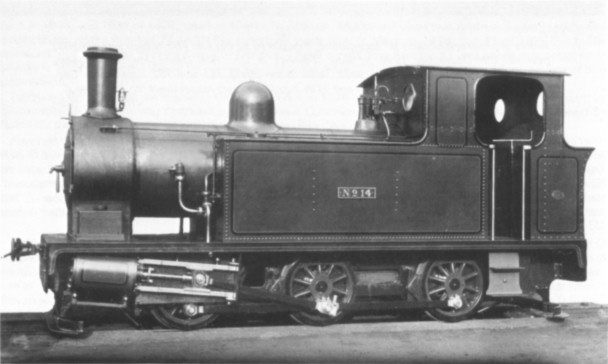
Bagnall's Catalogue No.18 (undated - but probably about 1913) shows a later example of the "Iddesleigh" type. 3ft 6in gauge No.14 (Bagnall 1933 of 1911) with 11in x 16½in cylinders was supplied new to the Lautaro Nitrate Co Ltd in Chile. The catalogue stated that it was a 'very carefully designed engine which has given great satisfaction to purchasers'. (collection K. P. Plant)
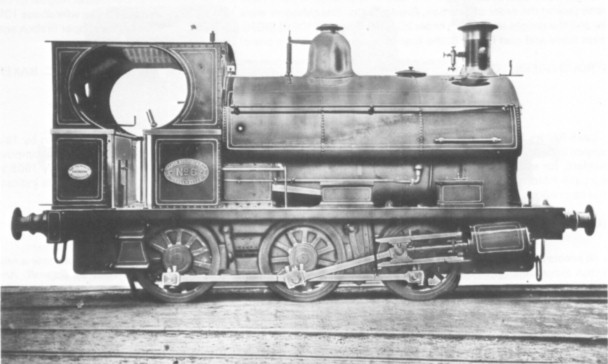
Works photograph of class B1 locomotive, thought to be Peckett 750, which was supplied new on 9th December 1898 to Geo. Thomas & Co, 72A Deansgate, Manchester. According to Peckett's boiler records, sister locomotives 781 and 782 supplied to Geo. Thomas & Co Ltd on 8th July 1899 and 14th July 1899 were respectively No.7 and No.8. (IRS Collection)
CORNISH BAL LOCOMOTIVES
Since seeing my letter on page 59 of RECORD 48 Jack Trounson has written to me with doubts as to the gauges of Basset Mines Ltd and C. M. Powder Co Ltd. Although he has quoted the gauge at Basset as 18in from a reliable source he now has his doubts considering the size of the locomotive. As it was apparently bought 'off the shelf' 60cm seems more likely - but has anyone definite information? With regard to the two Kerr Stuart locomotives which went to the C.M. Powder Co Ltd at Treamble from Dolcoath Mine, Mr Trounson doubts my statement that they were regauged from 1ft 10in to 2ft as only the minimum amount of work was done to them. He writes: "At Treamble I think the newer engine alone was used, and the other merely utilised for spare parts. I know that patches were put on the platework of the cab and tanks, and after one coat of grey lead paint she was put to work without even cladding on the boiler." My authority for quoting 2ft was a wagon I dug out of a stream at Treamble, and the reference on page B6 of Pocket Book B. Knowing how rough and ready some of these lines were, the locomotive may have been run without regauging although I feel some attempt must have been made to push the tyres out at least, only an inch each side being required.
| ILFRACOMBE, DEVON |
M.J. MESSENGER |
(It is perhaps pertinent to note that in the "Colliery Guardian" for 14th February 1919 tenders were invited for the plant of Bassett Mines Ltd (in liquidation) at Redruth which included a 30hp 20in gauge locomotive. — KPP)
WICK BREAKWATER
I am able to provide a few notes further to Rodney Weaver's letter on this subject (RECORD 49, page 95), taken mainly from my Gazetteer. For years an adequate harbour had been sought for the fishing fleet, but despite earlier works and two Acts of Parliament, little had been done, due mainly to lack of funds. By 1862 the Fisheries Society received Admiralty sanction to build a harbour of refuge at Pulteneytown (part of Wick) and work proceeded desultorily until 1874, by which time operations were halted by costs. Damage in the gales of 1871‑72 undid much of the work and each winter thereafter storms swept away portions of what partial construction remained! The waves were stated to break iron bars measuring 8in by 3in.
In 1879 a fresh Act was obtained and agreement with the Public Works Loan Commissioners enabled a modified (but inadequate) scheme to be completed in 1883. A deep-sea harbour, protected from the prevailing gales, remained impracticable at Wick: following examination of the entire east coast (again with Admiralty help) the harbour of refuge site was moved to Peterhead. Work began here about 1887 and was only recently completed. Thus over a century elapsed before the needs of the herring fishing fleet were met!
Construction at Wick was carried out by the little known contractors A. & K. McDonald, who used two Chaplin vertical boiler locomotives - works number 371, rated at 12 nominal horsepower, and despatched to Wick in 1864; and 1034 of 1868, rated at 15nhp. In addition, McDonald’s had two Andrew Barclay saddle tank locomotives: works number 74 (with 9in cylinders) went new to Wick in 1868, but 43 of 1866 (with 10in cylinders) was reputedly delivered new to Dundee. I have a note that Barclay 43 was eventually acquired by Shanks & McEwan Ltd but would be interested in learning more of the movements and subsequent fate of both locomotives.
Following the arrival of the Highland Railway at Wick in 1874 a branch was laid to the quay at Pulteneytown for commercial use. This was operated by the Harbour Commissioners with a Black Hawthorn loco named ST. FERGUS: the name is associated with the pre-Reformation Church in the district.
| KILSYTH, GLASGOW |
J. BROWNLIE |
KLEBER
With reference to this item on page 183 of RECORD 52, the September and December 1937 issues of the "Railway Magazine" contain some notes by M. Bègue and Baron Vuillet on the Royan Railway, situated on the south-west coast of France and running from Royan to Ronce-les-Bains. It is said that the rolling stock was in use at the Paris International Exhibition of 1889, and in order to popularise the 60cm gauge it was later taken to Royan where by 1937 it had been functioning for nearly fifty years. Eleven 0‑4‑2 side tanks and two 0‑6‑2 side tanks, weighing 7½ and 10½ tons each respectively, were built by Decauville for the line and the illustration of 0‑6‑2 side tank No.9 MARIE shows a "Kleber" in working trim. The rails used on the line weighed only 15 Ib/yd and the sharpest curves were 25 metres radius. I have always assumed that this railway was the first "Decauville" line. The extensive system in Calvados which was obliterated only in the Second World War I understood to be called the Chemin de Fer du Calvados, and was altogether a more substantial undertaking. Is there anything to support the claim of the Tramway de Pithiviers à Toury as an early "Decauville" system? Although not in the war zone, this line was very convenient to the surplus railway material available around that time. Certainly the main line to Toury was laid, in the end, with considerably heavier rail than the "Decauville" system propounds. One thing I cannot reconcile, and which I deduce from "Minor Railways of the First World War" by W.J.K. Davies, is that Dick Kerr petrol electric locos ran on 20lb rail. The axle load of these machines far exceeds the weight allowed for 20lb rail unless, perhaps, it was laid on a concrete slab! If one of these machines had been put on light track on the soft ground of north-east France I think it would have sunk in up to its axles.
| RIPLEY, SURREY |
J. L. BUTLER |
Students of French industrial and light railways will not have been surprised by the apparent uncertainties about the identity and destination of this locomotive as given in the note on page 183 of RECORD 52. The history of early, and indeed of most, Decauville locomotives is often obscure and has confounded enthusiasts on both sides of the Channel for much longer than my own interest in the subject which goes back now for about 25 years. There is no doubt that the subject is an enthralling one but there is equally no doubt that there is an almost complete lack of facts, this being one of the reasons which has influenced me in the past not to prepare an article on Decauville locomotives. Nowhere, as far as I can ascertain, does information exist which would enable the preparation of a study similar to that on Corpet Louvet which was published in RECORD 27. In the notes about KLEBER reference is made to "the Decauville works list" but does a definitive Decauville works list exist? I believe I know the list which is cited on page 183. It goes only so far as works number 327 and contains a number of omissions, inexactitudes and likely errors. I have not found anyone who is absolutely sure of its origin. Other uncertainties arise because Decauville contracted out to other firms, notably Couillet and Orenstein & Koppel, also probably Borsig, Hanomag, Henschel, Jung, Tubize and Weidnecht, and the locomotives were then given Decauville "works" plates. Only one thing is reasonably certain in a confused situation - Decauville themselves cannot help. After writing on more than one occasion I finally received a letter from them dated 31st May 1966 which said that their records had been destroyed when a munitions train exploded outside their Corbeil premises during the Second World War.
To move from the general to the particular; Decauville 128 was popularly believed to have been delivered new (about 1891) to the Chemins de Fer du Calvados (CFC) - later known as the Chemins de Fer des Couriers Normands (CFCN) - as their number 7 HERMANVILLE. This version was also given by Monsieur Chapins in an article some years ago in the Revue of the Federation des Amis des Chemins de Fer Secondaires (FACS). The locomotive was quoted as having been built to the system Weidnecht with cylinders measuring 250mm x 320mm and driving wheels of 650mm diameter: her weight was given as 10 metric tons. In December 1968 a well known FACS member, Bernard Rozé, wrote to Noel Needle saying that the article by M. Chapins contained more than one error and that Decauville 128 never went to the CFC. He gave no reason but may have been influenced by the fact that various sources said that the CFC had at least three locomotives numbered 7, namely:-
7 HERMANVILLE, an 0‑6‑2 outside cylinder side tank (system Weidnecht), Decauville 128 of c1891, delivered new. (Now discounted for the reason given above.)
7 GRANDCAMP (LUC-SUR-MER until 1896), an 0‑4‑4‑0 Mallet compound outside cylinder side tank, Decauville 110 of 1891, delivered new. Passed to the Chemin de Fer d'Interêt Local de Pithiviers à Toury in 1908.
7 (un-named), an 0‑6‑4 outside cylinder side tank, builder unknown. Rebuilt by Weidnecht from an 0‑6‑2 outside cylinder side tank and acquired in 1908 from Weitz, a dealer in Lyon.
The possibilities, therefore, are several. One is that Decauville 128 only ran trials on the CFC, although this is pure speculation and offers no explanation of the name HERMANVILLE attributed to it (and which was carried by another CFC locomotive). Another is that the first and third 7's are one and the same - speculation again and, if true, where did Decauville 128 actually go between the time of building and acquisition by Weitz? Did she ever carry the name KLEBER (or was this just draughtsman's licence?) and if so has it any significance? Perhaps another reader, more knowledgeable than me, can help clarify the true position. There was a report that Decauville 128 turned up about 1944, as an 0‑6‑4 side tank, at Compagnie Sucrière, Sucrerie de Vierzy, Aisne, where she carried the number 12; but as on other occasions with this locomotive, confirmation is once again lacking.
| TRING, HERTS |
K.W. CLINGAN |
(The "Decauville works list" is in fact a list of purchasers printed in Decauville's catalogue dated September 1901. — KPP)
SENTINEL LOCOMOTIVES 6751 AND 6770
I am a little puzzled at the review comments of the Sentinel locomotives on the Cliffe Hill Mineral Railway (RECORD 54, page 271). When I first visited Cliffe Hill on 13th August 1942, my notebook shows that I recorded Sentinel 6770CH with the name SAMSON: on 27th April 1947 the Sentinel 6770CH plate was still carried although the name SAMSON was not apparent. Sentinel 6751CH (plate carried) was lying out of use at the Barrasford Quarry, Northumberland, of the Northumberland Whinstone Co Ltd when I called there on 1st September 1947. Why therefore should it be assumed that each is really the other? It seems strange to me that 6751 should carry the plate of a later locomotive (6770) as is suggested. Is it not more likely that each carried the correct plate, and that the mix‑up was in correspondence or filing at Sentinel's?
I find the reference to the Wigglesworth Colliery Co Ltd very intriguing, and have so far not been able to trace this establishment. It would seem likely to have been a short-lived drift mine, but where exactly was it? And were there any other locomotives?
| BARROWFORD, LANCS |
B. ROBERTS |
(The comment in Trevor Lodge's review derived from information l located in Sentinel records some three years ago. 6751CH and 6770CH were two of the six new locomotives built at Chester by Sentinel Industrial Locomotives (England) Ltd from parts supplied by the main Sentinel works at Shrewsbury - from 20th November 1926 on (6751CH) and 25th November 1926 on (6770CH). The former was ordered on 28th September 1926 by Cliffe Hill Granite Co Ltd and the history sheet is quite boldly marked, "This loco bears the incorrect No plates for 6770". The latter was ordered on 11th October 1926 for delivery to the Hollymoor Colliery, Cockfield, Co. Durham, of the Wigglesworth Colliery Co Ltd, Horse Market, Barnard Castle. Unfortunately the Sentinel records I've seen are exceptionally meagre as far as the Chester locomotives are concerned, and no despatch dates are given. Maurice Billington suggests in his booklet that 6751 is reputed to have arrived at Cliffe Hill in January 1927, that a Sentinel locomotive was derailed and damaged on the day of its trial; and that a Sentinel (presumed to be 6770) was returned to the makers for extensive repairs in July 1927. It could be that 6751 did go to Cliffe Hill and was returned to the makers after its derailment, being replaced (owing to urgent need of motive power) by 6770; 6751 when repaired was then diverted to Wigglesworth; but this is all purely surmise. Has anyone some positive information?
In 1974 EP Publishing Ltd reprinted two catalogues — "Sentinel" Patent Locomotives and Concrete Cases - in one volume entitled Sentinel Patent Locomotives. An illustration of the Wigglesworth Colliery Sentinel appears on page 4 with comment on the facing page that it was "bought to replace an ordinary type of locomotive". This reference and the other information above was referred to Colin Mountford who reports that "Holly Moor Colliery, near Cockfield in South-West Durham (1in Ordnance Survey Map 84, Grid Reference NZ 115246) - also found as Holy Moor and Hollymoor — is believed to have been opened about the turn of the century. By the early 1920's it was owned by the Wigglesworth Colliery Co Ltd, one of quite a number of very small firms who owned pits in this area, though how long they had owned it is not known. It is believed that coal was obtained by means of a drift rather than a shaft, and from the pit a ¼mile long narrow gauge tramway ran down to screens alongside the LNER line from Bishop Auckland to Barnard Castle, ½mile north-east of Cockfield Station. It would appear that this tramway was only locomotive worked between 1926 and about 1929, though the colliery continued for a few more years under different owners." Any further information would be welcomed. — KPP)
PICTURE PARADE
EL PORVENIR, illustrated on page 322 of RECORD 56, is Krauss 2273 of 1889, built to 840mm gauge. The odd gauge should help identify the owner, though I couldn't find any appropriate Spanish industrial system of this gauge on a cursory search through my records. The similarity to the 0‑4‑0 well tank on page 323 suggests that this was also a Krauss loco, but the 0‑6‑0 well tank (also page 323) is somewhat different. The two Krauss locomotives, however, demonstrate once again that many Arthur Koppel locos were built by makers other than Orenstein & Koppel. Indeed, I doubt whether the 0‑6‑0 well tank was built by Orenstein & Koppel, due largely to the design of the cylinders and valves. Nearly all O&K locos, except those built to the designs of the Prussian State Railways or Deutsche Feldbahn, have flat-topped valve covers of the type shown on the locomotives on page 108 of RECORD 38. I know of no authentic O&K locos, other than the external designs mentioned above, with the sloping type of valve cover. For this reason I am convinced that the "Koppel" loco at Penlee Quarries, Cornwall, was not built by O&K: Krauss seems to me the most likely builder. Krauss, incidentally, built several locos for Arthur Koppel about 1900, two of which were for England. These were Krauss 4989 and 5059, 600mm gauge 0‑4‑0 tank locos built in 1904. In addition, seven Krauss 0‑4‑0 tank locos of 600mm and 610mm gauge were built for A. Koppel but for which no destination is shown in the list. The seven concerned were Krauss 3542, 3543, 3544, 3584, 4011, 4012 and 4361. It is possible that the "Koppel" loco at Penlee Quarries was one of these engines, and Krauss 4361 of 1900, built to 610mm (2ft) gauge, would seem to be a likely contender.
| BRISTOL |
MARTIN MURRAY |
(It would appear that few continental-built steam locomotives were used in Britain, and we would welcome further information on this neglected topic. — KPP)
As readers will be aware, no locomotives were built by Arthur Koppel: so called Arthur Koppel locos were simply some other builder's engines fitted with Arthur Koppel plates. The three illustrations on pages 322 and 323 of RECORD 56 represent standard Krauss engines. The Krauss works list is full of locomotives built for A. Koppel, and I have also seen Orenstein & Koppel engines with A. Koppel plates. This often causes confusion - in fact there is an engine in Australia which carries no builder's plates and no works number on the motion but was supplied by A. Koppel and built by some unknown maker to Krauss design!
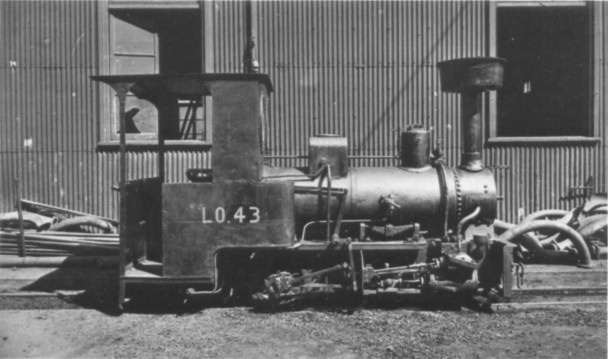
I enclose a photograph of Krauss 2179 of 1889, a Class IVqq loco which had quite a varied ownership, being built for John Robb, a contractor on the Victoria Dock construction in Melbourne. By about 1892 it was with the South Australia Water Supply Department, Happy Valley Reservoir (Adelaide area), but from about 1896 to 1910 the ownership is not known. In 1910 it became New South Wales Public Works Department No.23 and in 1917 was renumbered to LO.43. Newbold's General Refractory Company (NSW) purchased it in 1936 and are thought to have scrapped it at some unknown date. Several features on this locomotive are similar to those of the engravings in Picture Parade.
| COS COB, CONNECTICUT, USA |
CHARLES S. SMALL |
CRAMLINGTON COAL CO LTD
The item reproduced from the "Locomotive Magazine" on page 343 of RECORD 57 is incorrect insofar as Backworth Collieries Ltd did not amalgamate with the other two companies as suggested but remained a separate concern until nationalisation.
| YORK |
J.B. DAWSON |
A KILMARNOCK MISCELLANY
I was very interested to see the reproduction of the Grant Ritchie advertisement on page 375 of RECORD 58. A list of Grant Ritchie locomotives which I have compiled indicates only two possible candidates for the Hallside Steelworks. One is a locomotive recorded as delivered in 1879 to the Scottish Iron & Steel Company, though no details of exact location are given. No works number appears to have been allocated, and details of the wheel arrangement and cylinder size are also lacking. On the basis of the few locos constructed before this one I am inclined to think that the most likely type would be an 0‑4‑0 saddle tank. The second candidate is Grant Ritchie 40, built in 1880 for the Steel Company of Scotland. This was an 0‑4‑0 saddle tank with 12in by 20in cylinders where the destination was not recorded. It seems rather strange that there is no mention of Hallside Steelworks in the locomotive list, although this features prominently in the advertisement!
| ROCHESTER, KENT |
JOHN BENSON |